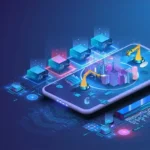In the developing time, the role of (IoT) has crossed the vast range of business networks of connected devices ,software and other technologies. These devices serve the spectrum of gadgets like smartphones and wearables to specialized machinery in industries such as healthcare ,manufacturing and agriculture . IoT enables seamless communication and data exchange between physical objects and digital systems leading to enhanced automation, efficiency, and insights vision.
Let’s dig deep into it. But before moving ahead, here are some interesting stats related to IoT technology.
Statistics on Internet of Things IoT Concept
● According to survey report given by Statista,the global IoT market is expected to reach 21.09 billion by 2026
● Another survey done by IoT-Analytics found that 29.7 billion connections got connected to IoT endpoints
● These surveys reveal that strategic comparison along with businesses which thrive in the era of IoT-driven customer integration can create lasting value for their stakeholders.
Importance of IoT in Custom Software Development Services
IoT devices are changing the vision of custom software development with improved technologies. When it comes to addressing diverse business needs, these devices provide users with scalability, flexibility beyond the top software. Organizations can harness the data insights by using the data generated by IoT devices in a custom software. Let’s highlight some key features of IoT in software development process-
- Analysis capabilities with data collection
- Improved automation with efficiency
- Monitoring ability with device control
- Facilitating Innovation with fostering sustainability
Let’s go through the core benefits of integrating IoT in the process of developing customized software.
Benefits of Integrating IoT in Custom Software Development
Here are several benefits of IoT technology in software development process-
1. Improved Operational Efficiency
IoT devices can automate time-consuming tasks by reducing manual intervention and increased operational productivity. It can also assist companies to save cost and effort that further translate into a high ROI.
2. Predictive Maintenance with Cost Savings
IoT enabled software solutions can help companies deal with equipment failures and maintain needs with cost-saving opportunities through the given data management and performance.
3. Enhanced Safety and Security
IoT offers safety measures with security parameters by monitoring threats or risks and gives a safer environment for users. Regular security audits and updates are essential to stay ahead of emerging threats.
4. More Interoperability with Prioritising security
In the software development process, security is paramount when integrating IoT with standardized communication protocols and frameworks. This integration facilitates seamless interaction between diverse IoT devices and software platforms.
5. Higher Scalability with Data Encryption
In scalability the software are designed with data encryption solutions by safeguarding data integrity and confidentiality, mitigating the risk of unauthorized access or tampering to accommodate the growing influx of IoT devices and data.
6. Accurate Edge Computing and Testing
In edge computing with respect to testing of process data closer source, reducing latency and bandwidth requirements. Edge analytics enable real-time insights and decision-making, enhancing responsiveness and agility in IoT-driven applications.
It is fair to mention that IoT can open the doors of new possibilities in custom software development. Integration of features based on this technology can make the software more reliable and powerful than ever.
Navigating Integration Complexities in IoT Horizon
In the age of digitalization, navigating the IoT concept gives a proper landscape idea for device diversity and gives solutions to various complexities .IoT generates massive volumes of data streams that require analysis and ingestion. IoT Prioritizes security throughout the IoT ecosystem with robust authentication, encryption, access control and secure update mechanisms.
By understanding and addressing (IoT) integration complexities proactively, developers and users can build robust customized IoT solutions that deliver value to businesses and end-users alike. Embracing standardization, security, scalability, and best practices in integration perfectly improves the way for successful Iot deployments in the ever- expanding IoT horizon.
How to Improve User Experience with IoT Software
Tailored IoT solutions play an important role in improving user experiences in various industries. By collecting and analyzing data from connected devices ,businesses can gain valuable insights into user behaviour and preferences ,enabling them to deliver personalized services and products.
IoT Capitalize sensors and contextual data which deliver context- aware experiences which adapt users’ surroundings ,activities and their preferences in real time. Here is how IoT integration into the software development can improve user experiences-
● Intuitive User Interfaces
In the realm of IoT, simplicity remains supreme. It has a special design user interface (UI) for user experiences (UX) that are intuitive and easy to navigate. It also minimizes complexibility and provides clear guidance to users to enhance usability.
● Information Architecture
Information Architecture is definitely the best for user experience approach that adds value for both the consumer and industrial growth. It acts as a catalyst for a rich user experience in customized IoT software.
● More Control
As security remains a top-notch priority, it remains a big concern in IoT deployments. In Custom software development services, users prioritize robust security measures to safeguard their data and privacy.
● Real- time feedbacks and Alerts
IoT implements features that provide real-time feedback and update users through IoT sensors and devices. Moreover, IoT allows push notifications, alerts, and dashboard visualizations to empower users to stay informed and take proactive actions.
IoT is an advanced and revolutionary technology that enables custom software to remain user-friendly. Advancements of this technology can take user experiences to a new level.
Conclusion
The integration of IoT technology into custom software development has always played a significant role in the new era of innovation and efficiency. It has an undeniably transformative impact offering businesses unprecedented opportunities for growth power of real-time data insights, automation, and personalized experiences. Striking the balance between power connected devices and real- time data, businesses can develop tailored solutions that streamline processes, enhance productivity, and drive growth.
As we move ahead, it’s essential for organizations to have a clear vision in the digital landscape. At last but not the least ,IoT in custom software development isn’t just about adopting the latest trend; it is about future-proofing your operations and unlocking new opportunities for success. So, let’s embrace the transformative power of IoT and pave the way for a smarter, more connected future.





